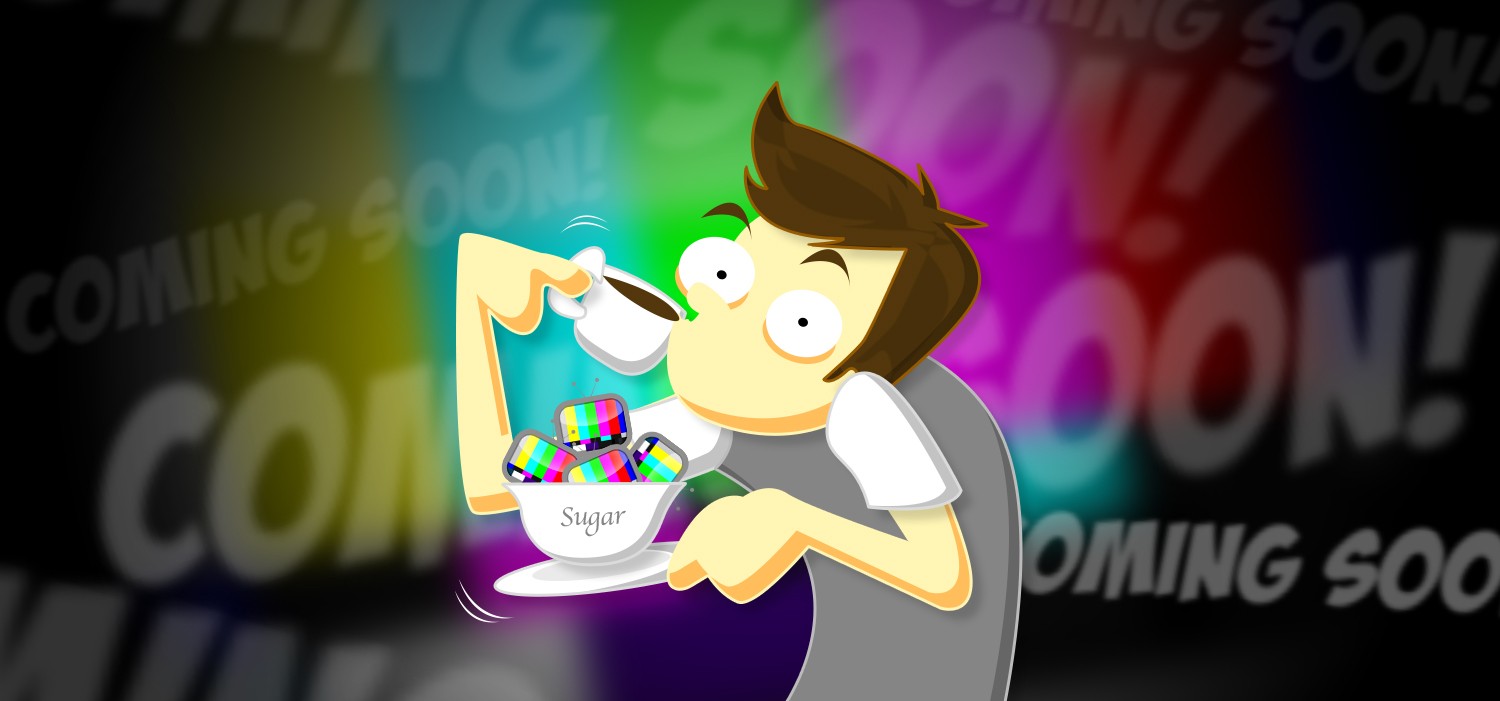Overhyped
Ever expected something to be more than it really is? Being in the advertising and design industry, we’re often tasked with helping companies sell their products and ideas. Hype-building is essential, especially when marketing large projects. Drawing consumers in, encouraging purchases and engagement, and giving them a taste of what’s to come helps ensure profits. But what happens when the build-up is better than the end product? If we’re fed a huge dessert, are we still hungry for the main course? Let’s review some of the latest media sugar highs and their lows.
No Man’s Sky
Starships. Endless alien worlds. Lush environments teeming with activity. The trailers kept us longing for its release on the PlayStation 4 and PC. Gamers were looking forward to this title the way astronomers anticipated the New Horizons flyby of Pluto. No Man’s Sky almost didn’t happen, but thanks to the small, incredibly talented team pushing it forward, people around the globe cheered them on. To many, it would be the game of the decade. What we received is a massive digital universe with everything to discover, everywhere to go… and very little to do. Yes, at 18 quintillion planets, NMS generates sprawling play fields, albeit with cookie cutter scenarios. Alien life is binary from world to world; either hostile or non-hostile. The trailers treated us to action-packed flight, herds of creatures interacting with the landscape, and being able to gather and craft with found resources. It could very well be players haven’t yet traversed deep enough the game’s universe to discover enough variety. It’s forgivable for a company to drop certain features of a title in development after having dangled carrots before our eyes. NMS is no exception and we can certainly expect patches. The consensus remains that consumers were shown too many treats that remain to be delivered. For now, there is no forming of alien allegiances, no compendium of discovered resources, very low likelihood of interacting with other players, and no driving conflict. It isn’t a horrible game by any stretch. Dull would be the better term, though relaxed is most accurate. And stay tuned, as rumour has it that base building will be delivered in a future patch.
Suicide Squad
DC Comics and Warner Brothers built us up for one heck of a summer blockbuster. It featured Will Smith, Jared Leto, Margot Robbie, Joel Kinnaman, Viola Davis, Jai Courtney, Jay Hernandez, Adewale Akinnuoye-Agbaje, Ike Barinholtz, Scott Eastwood and Cara Delevingne as a rag-tag team of B-list villains tasked with saving the world from meta humans who have the potential to turn rogue. Fans were stoked to have a movie filled with the dark side of the Batman universe, with the expectation of dark humour akin to Deadpool. We were given an undeniably astounding depiction of fan favourite antagonist Harley Quinn, girlfriend of the Joker. And perhaps that’s all the movie really needed. Instead, we were overwhelmed with side characters and underwhelmed with character development. This led to an inability to build any real emotional connection with anyone in the movie in the two-hour timeframe of the film. Jared Leto as the infamous Joker was for many a driving force to see the movie. However, too much of him was revealed in promotional clips and trailers, with very little of him in the film. It’s safe to say we saw all of his best parts before the film hit theatres. What we have is a movie about Harley trying to get back to her love, the Joker, with third wheel, Deadshot. Perhaps WB intended to set the stage in Suicide Squad for a future dark romance?
Pokémon GO
Pokémon, a portmanteau of Pocket Monsters, are creatures able to be captured, trained, and evolved in the game of the same name. Niantic and The Pokémon Company, the forces responsible for the newest instalment in the Pokémon world, had us believing Pokémon would be running about the streets in real time. Seen through augmented reality on phones, trailers enticed us with realistic looking Pokémon walking down paths, flying in the sky, hiding in the grass, and interacting with the natural environment around the player. Using GPS coordinates, a Pokémon could be found, with hints including how many metres away from the creature you were, captured, traded, rescued from attacking Pokémon, participate in random battles outside of a gym, and more. But when Pokémon GO launched, for many it felt like playing the Atari version of a high-budget film. Battles can only be held at gyms. No trading Pokémon. No quests. Too many of the same Pokémon. While actually hunting the creatures is fun, there’s not much meat and potatoes to the game. At best, Pokémon GO is a FitBit for all ages. You must walk to hatch Pokémon eggs, be mobile to make new Pokémon appear for catching, travel to Pokéstops to collect items, and battle at gyms to prove that you’re the very best. It’s a visual far cry from the trailer with plummeting user engagement by the day, but it’s a fun interactive game to encourage physical fitness nonetheless.
iPhone 7
Apple’s iPhones sell themselves, along with an amazing event to kick off the launch. As a status symbol representing the cream of technology, Apple has had to compete namely with Samsung. As a result, Apple is kept on their toes, fastidiously releasing new iPhone models and continually reminding us that the newest model will improve our lifestyles. So when the newest member of the iPhone family is announced, people rejoice. Enter the iPhone 7 and the iPhone 7 Plus. Offering water-resistance and a dust proof exterior, the sleek new models include new cameras, with the 7 Plus model sporting a second rear camera with 2x optical zoom for beautiful photos. The hype over the newest addition to Apple’s array has been met with mixed reviews, notably with criticism over the apparent lack of a headphone jack. To offer a thinner, water resistant body and to compete with rival devices, headphones can plug into the lightning jack via dongle, alleging better sound quality. But is Apple simply after a profit on selling wireless headphones, aware of a general annoyance of plugging in a dongle to charge your phone and listen to your songs at the same time? Samsung’s Galaxy devices claim better water resistance over the iPhone 7 despite still having a headphone jack. For $159 USD you can accessorize with Apple’s AirPod wireless headphones, which automatically detect your nearby phone. But with no tether to keep the earpieces from going missing, you might find yourself spending more time searching for your AirPods than you do listening to them. Unless you’re sold on taking potentially better photos and wireless headphones, a new iPhone might not be the purchase of the year.
Hoverboards
2015 was the year of the Hoverboard, according to Back to the Future II. Seen as the coolest piece of technology at the Consumer Electronics Show in Las Vegas, companies took notice around the world, making their own versions, and marketing them to celebrities to spur their popularity. Providing a top speed of about 10mph, a range of 12 miles, and accommodating of riders up to 220lbs, the Hoverboard took holiday season wish lists like wildfire. And then came a major flaw. Marty Mcfly’s hover board in Back to the Future never caught on fire, but that’s exactly what happened. A product by the same name but not the same concept, these rolling electric scooters were a cool way to get around on two wheels while standing on two feet. The design of the board’s power source was to blame for the demise; the rechargeable lithium-ion batteries in the foot rests could cause your board to go up in flames. Like the $5000USD Segway of 2001, this innovative way to get around was on most wish lists. The rage to have a Hoverboard lasted just six months. Announced unsafe by the Consumer Product Safety Commission in February 2016, this invention needs to stay out of the future and go back to the drawing board.
At the end of the day, it’s normal to be drawn in with the masses and to want to see what all the fuss is about. No Man’s Sky is still a breathtaking game, Suicide Squad is still a fun movie, Pokémon GO still has updates, and Hoverboards can always be improved upon. Hype is served to us, we drink it up, we ask for more. What can be learned is that what is popular is not always successful; what is successful is not always popular.


